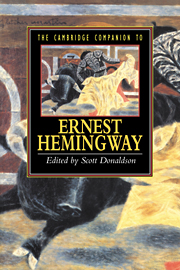Book contents
- Frontmatter
- 1 Introduction
- 2 Hemingway's journalism and the realist dilemma
- 3 1924
- 4 In Our Time, out of season
- 5 Brett and the other women in The Sun Also Rises
- 6 A Farewell to Arms
- 7 Hemingway's late fiction
- 8 Hemingway and politics
- 9 Hemingway and gender history
- 10 Hemingway, Hadley, and Paris
- 11 Hemingway's Spanish sensibility
- 12 The Cuban context of The Old Man and the Sea
- 13 Conclusion
- Selected Bibliography
- Index
- Series List
10 - Hemingway, Hadley, and Paris
The persistence of desire
Published online by Cambridge University Press: 28 May 2006
- Frontmatter
- 1 Introduction
- 2 Hemingway's journalism and the realist dilemma
- 3 1924
- 4 In Our Time, out of season
- 5 Brett and the other women in The Sun Also Rises
- 6 A Farewell to Arms
- 7 Hemingway's late fiction
- 8 Hemingway and politics
- 9 Hemingway and gender history
- 10 Hemingway, Hadley, and Paris
- 11 Hemingway's Spanish sensibility
- 12 The Cuban context of The Old Man and the Sea
- 13 Conclusion
- Selected Bibliography
- Index
- Series List
Summary
In 1933, five years after moving to Key West with his second wife, Pauline Pfeiffer, Ernest Hemingway revisited Paris and there composed a travel letter for Esquire magazine about the “gloomy” mood of the city where he had spent six momentous years in the 1920s. His return seemed “a big mistake”: Some old friends had killed themselves, others clung to the past by scribbling memoirs, and everyone seemed “very discouraged.” The painters complained that nobody was buying their work, and the big cafes in Montparnasse teemed with “refugees from Nazi terror” - as well as with German spies. Everyone assumed the stark inevitability of another world war. But Hemingway's somber report seemed finally to mask a private grief, betrayed near the end of the letter when he evoked the plangent image of the city as a forsaken mistress:
Paris is very beautiful this fall. It was a fine place to be quite young in and it is a necessary part of a man's education. We all loved it once and we lie if we say we didn't. But she is like a mistress who does not grow old and she has other lovers now. She was old to start with but we did not know it then. We thought she was just older than we were, and that was attractive then. So when we did not love her any more we held it against her. But that was wrong because she is always the same age and she always has new lovers.
- Type
- Chapter
- Information
- The Cambridge Companion to Hemingway , pp. 197 - 220Publisher: Cambridge University PressPrint publication year: 1996
- 2
- Cited by



